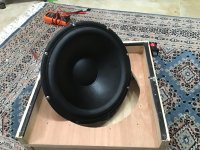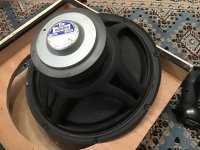Hi Agent.5,
I've found no published calculators for modeling a Ripol, so I based the dimensions for mine on the guidelines posted by a respected Ripol builder on this forum, under the user name "Rudolf".
These guidelines are quoted below:
Area of front chamber opening should be 1/3 to 1/4 of woofers’ combined piston area (SD).
For woofers having more than 10mm X-max, use 1/3 SD minimum.
For woofers with 10mm or less X-max, chamber area can be 1/4 SD.
Area of rear chamber opening should be 1/2 to 1 SD.
Chamber depth need not be greater than necessary to fit the woofer.
I've found no published calculators for modeling a Ripol, so I based the dimensions for mine on the guidelines posted by a respected Ripol builder on this forum, under the user name "Rudolf".
These guidelines are quoted below:
Area of front chamber opening should be 1/3 to 1/4 of woofers’ combined piston area (SD).
For woofers having more than 10mm X-max, use 1/3 SD minimum.
For woofers with 10mm or less X-max, chamber area can be 1/4 SD.
Area of rear chamber opening should be 1/2 to 1 SD.
Chamber depth need not be greater than necessary to fit the woofer.
Hey, you're welcomed. But I should tell you there is a downside to going with larger woofers.
The Ripol's front chamber will have a nasty-loud chamber resonance that would not be pleasant to hear.
Think of it as the sound you hear when you blow air into a jug, and a larger jug has a lower pitch resonance.
In the case of a Ripol with 12" woofers, that resonance will be somewhere between 200-300 Hz, depending on the chamber size. You can either avoid exciting this resonance (as I do) by setting the crossover frequency at least one octave below it using a steep filter slope (I use 24db/octave). Or, you could build a passive notch filter to tamp down the resonance peak (this would require some trial and error to dial in).
Or you could use a DSP and overlay a parametric EQ to tamp down the resonance.
If you're OK with a notch filter or parametric EQ, then use whatever woofer you like and cross it in wherever you wish.
But if prefer to avoid the resonance with an octave lower crossover... a larger Ripol would severely limit the usable bandwidth below the resonance. Let me explain:
For a Ripol with 12" woofers having a 220Hz chamber resonance, you would then need to crossover no higher than 110Hz, which is fine for a sub, but you may not want to go lower.
For a larger woofer (let's say 18"), the chamber would be much larger and so the resonance would be much lower. In this case, an octave lower might require a crossover down to 50Hz, which would severely limit the usable bandwidth below the resonance.
The Ripol's front chamber will have a nasty-loud chamber resonance that would not be pleasant to hear.
Think of it as the sound you hear when you blow air into a jug, and a larger jug has a lower pitch resonance.
In the case of a Ripol with 12" woofers, that resonance will be somewhere between 200-300 Hz, depending on the chamber size. You can either avoid exciting this resonance (as I do) by setting the crossover frequency at least one octave below it using a steep filter slope (I use 24db/octave). Or, you could build a passive notch filter to tamp down the resonance peak (this would require some trial and error to dial in).
Or you could use a DSP and overlay a parametric EQ to tamp down the resonance.
If you're OK with a notch filter or parametric EQ, then use whatever woofer you like and cross it in wherever you wish.
But if prefer to avoid the resonance with an octave lower crossover... a larger Ripol would severely limit the usable bandwidth below the resonance. Let me explain:
For a Ripol with 12" woofers having a 220Hz chamber resonance, you would then need to crossover no higher than 110Hz, which is fine for a sub, but you may not want to go lower.
For a larger woofer (let's say 18"), the chamber would be much larger and so the resonance would be much lower. In this case, an octave lower might require a crossover down to 50Hz, which would severely limit the usable bandwidth below the resonance.
how do you determine the size of the front facing slot and 2 back facing slots? Is it based on surface area of speaker cones x some number?
@agent.5 : see @CharlieM 's webpages under the name Jazzman. The links should be :
http://jazzman-esl-page.blogspot.com/2011/01/ripole-subs-are-underway.html
https://www.avsforum.com/threads/jazzmans-sls-ripole-subs.1487304/
You have all the explanations - they match with the informations given by Mr. Axel Ridtahler, the inventor of the Ripole principle.
Aw, sorry, you already reminded them @CharlieM !
I will just add that point, source of possible confusion - if you build a 2-speakers Ripole :
- for the single front chamber opening, you calculate with twice the SD of one speaker, since there are two speaker exhausting by that common opening.
- for each of the rear chamber openings, you calculate with the SD of one speaker only, since each speaker has its proper independent opening.
T
Last edited:
I would think that it will reduce efficiency and hurt low end cutoff having both openings closer to each other compared to 180 degrees apart. The further apart in distance the openings are from each other would improve low end response, sort of like increasing the baffle area on an open baffle design.
Could this woofer be a good replacement?
I found the following woofer from SB acoustics. What do you think? It should be very suitable - low FS, high linear excursion, high QTS, lightweight membrane, nice constrction, not very expensive.
You could use three of the 16 ohm variant connected in parallel and thus compensate for the low efficiency without having to use a housing that is too tall
I found the following woofer from SB acoustics. What do you think? It should be very suitable - low FS, high linear excursion, high QTS, lightweight membrane, nice constrction, not very expensive.
You could use three of the 16 ohm variant connected in parallel and thus compensate for the low efficiency without having to use a housing that is too tall
Attachments
Hey, you're welcomed. But I should tell you there is a downside to going with larger woofers.
The Ripol's front chamber will have a nasty-loud chamber resonance that would not be pleasant to hear.
Think of it as the sound you hear when you blow air into a jug, and a larger jug has a lower pitch resonance.
In the case of a Ripol with 12" woofers, that resonance will be somewhere between 200-300 Hz, depending on the chamber size. You can either avoid exciting this resonance (as I do) by setting the crossover frequency at least one octave below it using a steep filter slope (I use 24db/octave). Or, you could build a passive notch filter to tamp down the resonance peak (this would require some trial and error to dial in).
Or you could use a DSP and overlay a parametric EQ to tamp down the resonance.
If you're OK with a notch filter or parametric EQ, then use whatever woofer you like and cross it in wherever you wish.
But if prefer to avoid the resonance with an octave lower crossover... a larger Ripol would severely limit the usable bandwidth below the resonance. Let me explain:
For a Ripol with 12" woofers having a 220Hz chamber resonance, you would then need to crossover no higher than 110Hz, which is fine for a sub, but you may not want to go lower.
For a larger woofer (let's say 18"), the chamber would be much larger and so the resonance would be much lower. In this case, an octave lower might require a crossover down to 50Hz, which would severely limit the usable bandwidth below the resonance.
If you angle the the top and bottom surfaces of the chamber you can avoid the resonance issue by eliminating the parallel surfaces
Last edited:
@cab Your comment about the producing a non-parallel inner chamber for the chambers Top/Bottom Walls has caught my interest.
In a chamber design I put on paper a few years ago, I had the Chamber Side Walls able to be adjusted from being a wider / smaller chamber exit dimension than that of the parallel dimension across the chambers width.
Would a chamber with a height dimension being able to be adjusted in a similar way to the width dimension that I hade put on paper +/- parallel, be further advantageous to being limited to increasing the dimension only?
Is there a dimension range that could be suggested as a dimension range to be used as the increased / decreased dimension to the Parallel dimension. I have to ask as the Cabinet Design takes a little thinking through. At present my thoughts are that Chamber can be created that has a flare as the chambers exit that is Flared Out to being reduced to lesser that parallel as the Flare.
In a chamber design I put on paper a few years ago, I had the Chamber Side Walls able to be adjusted from being a wider / smaller chamber exit dimension than that of the parallel dimension across the chambers width.
Would a chamber with a height dimension being able to be adjusted in a similar way to the width dimension that I hade put on paper +/- parallel, be further advantageous to being limited to increasing the dimension only?
Is there a dimension range that could be suggested as a dimension range to be used as the increased / decreased dimension to the Parallel dimension. I have to ask as the Cabinet Design takes a little thinking through. At present my thoughts are that Chamber can be created that has a flare as the chambers exit that is Flared Out to being reduced to lesser that parallel as the Flare.
resonance is produced both by material vibration and cavity standing waves. If there is no cavity there should be very little issues with standing waves. Apparently, there can be issues with non-axial resonances forming in the case of non-parallel wall cavities but these are much less an issue.
For sale a pair of Peerless sls12 drivers. Excellent condition. Used for 3 years or so.
Will pack expertly and ship via usps priority Enclosre shown not available.
$75 each plus shipping.
Will pack expertly and ship via usps priority Enclosre shown not available.
$75 each plus shipping.
Attachments
Do you have the drawings for this design?I'm not sure that the Eminence Kappa 15C would be the epitome for a Ripole subwwofer : Fs is fine, Qts is a bit low and Xmax is small, where you would need 8-10mm...
View attachment 1199772
But OK, as usual it is a matter of test : build a cheap Ripole test box and see if it already works as you expect... As you already own the speakers !
For my Omega Ripole (personal design), I used 12" speakers for a matter of available place. The speakers are two BEYMA 12BR70, which offer a Fs at 30Hz, a Qts at 0.5 and a Xmax at 8mm. Plus they are ruggered and very affordable units !
View attachment 1199773
View attachment 1199775 View attachment 1199776
I measured a Fs of the system at 16Hz for a 6WRMS signal delivered to the paralleled speakers, which is quite good for a 400x400x440mm box.
T
- Home
- Loudspeakers
- Subwoofers
- Bad news for Ripole sub builders :-(

